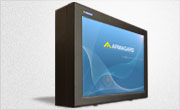Digital Signage – The Cost of a Damaged Screen
Posted by: Richard Williams | Posted on: | 0 Comments
Digital signage is a growing industry but the one thing that puts off newcomers into getting involved is the initial investment and uncertainty of getting a return.
This is exaggerated in the world of outdoor digital signage where the set-up costs are a lot higher. While digital signage can be used for multiple purposes: Advertising, Information, Branding – getting a return on the initial investment is still highly important.
Cost of damage
When a screen is damaged, the additional costs that it can incur will lengthen the time the return on the initial can be recouped but if the devices continue to fail or suffer damage this return on investment may never arrive.
Not only will a damage screen incur the cost of replacement and repair, a dead screen (one that is not working) will not be attracting new customers or promoting products meaning the longer it is out the longer a return on investment will be forthcoming.
Causes of damage
There are two common causes for disabled and damaged digital signage screens:
- Inadequate protection from the surrounding environment
- Inadequate protection from impacts, vandalism and accidents
In addition, outdoor digital signage is more prone to such incidents of failure than indoor systems this is because not only are outdoor digital screens are usually left unattended in unsupervised areas but also they have to cope with the rigors of the weather and varying temperatures of an outdoor environment.
While outdoor digital signage is more vulnerable to these incidents, even indoor screens are vulnerable to damage in these ways as many shopping malls, subways and retail parks where these screens are located are not the ideal environments for modern screens – designed as most of them are for ambient room temperature and the confines of homes and offices.
Protection
Protection for digital screens, whether they are for indoor or outdoor use is therefore important and shouldn’t be underestimated. Not only should the screens themselves be protected from impact and damage but also they should be only run in the temperature and environmental ranges they were designed to operate.
An LCD enclosure offers both physical protection from vandalism, theft and impacts, including eh use of a shatterproof screen but also inside the enclosure the entire environment is the optimum conditions for running a screen; kept at the right temperature range with cooling fans and the housing is a 100% waterproof TV enclosure
Post shortlink:
Popular Products
LCD Enclosure
Need armor for your LCD/LED screen(s)? Outdoors or inside the versatile LCD enclosure protects against thieves, vandals & the weather. Installation idea: NFL stadiums.
Outdoor Digital Signage
Exclusive 46” outdoor screen protection. Dubbed the ‘Totem’, due to its distinct design, it repels damage threats, but attracts audiences. Installation idea: Drive-thru restaurants.
Portrait Flat Panel Enclosure
Safeguard your eye-level advertising display screen(s), indoors or outdoors. Completely customizable, add exciting features like touch screen technology. Installation idea: Restaurant frontages.
Indoor Digital Signage
Popular purchase for retail outlets! Great for ‘point of sale’ persuasion, boost your brand with static & motion advertising from a single unit! Installation idea: Mall of America.




